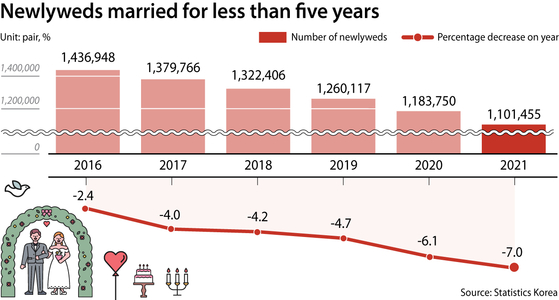Number of Korean newlyweds falls at its sharpest rate yet
![A shopper walks by a wedding dress shop in Ahyeon-dong, Mapo District, western Seoul, on March 17, 2022. [YONHAP]](https://koreajoongangdaily.joins.com/data/photo/2022/12/12/d3acf824-686c-41d5-9f2c-c05446db3540.jpg)
A shopper walks by a wedding dress shop in Ahyeon-dong, Mapo District, western Seoul, on March 17, 2022. [YONHAP]
The total number of newlyweds in Korea last year dropped 7 percent on year, the sharpest decline since related data began to be complied in 2016.
Covid-19 was considered to be the biggest factor behind the sharp decline, though the changing social perception of marriage was also considered to play a significant role.
According to Statistics Korea on Monday, last year there were 1.1 million newlyweds, defined as couples that have been married five years or less and in which at least one person is a Korean. That's 82,000 less than the number recorded in 2020.
“As the number of people getting married decreased significantly due to the Covid-19 pandemic, the number of newlyweds plummeted,” said Cha Jin-suk, director of the policy statistics team at Statistics Korea.
The situation appears even more stark when the scope is narrowed down to couples who have been married less than a year. This came out to 191,904 couples, a 10.4 percent decrease on year.

In recent years though, the number of newlyweds has been on a decline even without the pandemic. Economic factors including job security and the trend of staying single becoming a social norm were key factors that kept people from tying the knot.
Even among married couples, the social changes were visible.
While dual-income couples have further increased, more couples are having less children.
Last year, the number of dual-income couples accounted for 54.9 percent, which is a 2.9 percentage-point increase compared to 2020.
Dual-income couples broke 50 percent for the first time in 2020.
The combined annual income of newlyweds averaged 64 million won ($48,800), up 6.9 percent. The average income of all dual-income couples was 80 million won whereas single-income couples averaged 48.1 million won.
With more couples in which both people work, there were less children.
Among those married five years or less, 54.2 percent have children: a 1.3 percentage-point drop from the previous year.
When looking at single- and dual-income couples, 60.5 percent of single-income couples have children whereas 49.6 percent of dual-income couples have children.
The presence of children also seemed to play a role in whether the couple purchased a home or not: 59.9 percent of newlyweds with children lived in a place that they owned, compared to 50 percent of couples without children.
Some 89.1 percent of newlyweds were in debt, up 1.6 percentage points. The median outstanding debt amounted to 153 million won ($117,000), which is a 15.4 percent increase compared to 2020.
It's the biggest jump since data has been complied.
Those that owe between 100 and 200 million won accounted for the largest portion at 30.7 percent.
“This seems to be due to the increase in newlyweds’ jeonse [long-term rent deposit] loans and mortgages,” said the statistics agency official Cha.
Among married couples, 79.1 percent were those that were married for the first time, down 0.1 percentage points from 2020. Those who remarried were up 0.1 percentage points to 20.6 percent.
BY CHO HYUN-SOOK, LIM JEONG-WON [lim.jeongwon@joongang.co.kr]










with the Korea JoongAng Daily
To write comments, please log in to one of the accounts.
Standards Board Policy (0/250자)